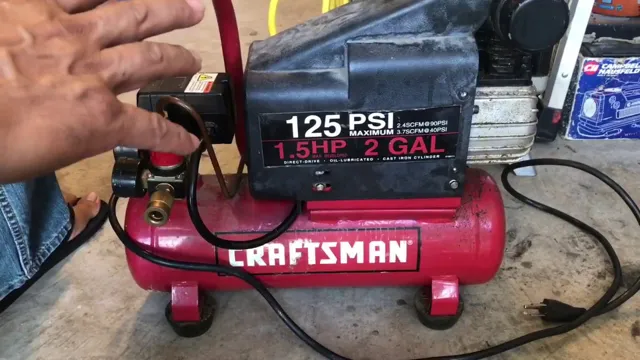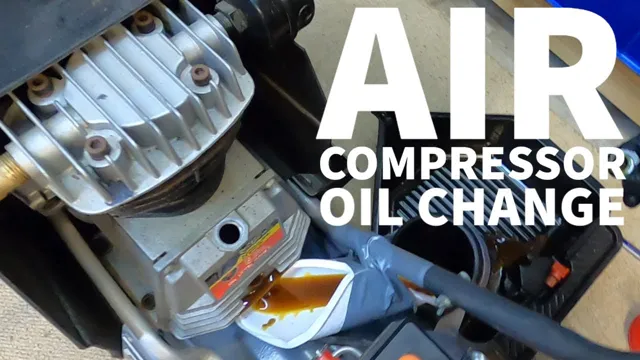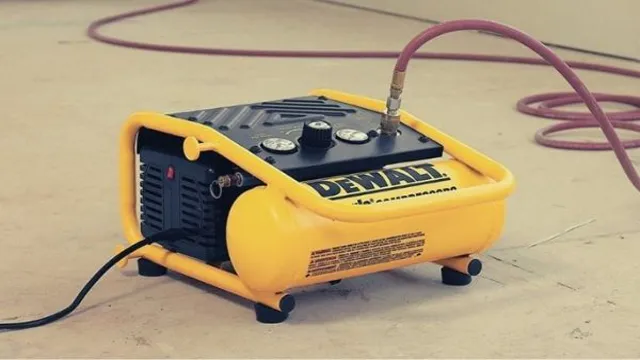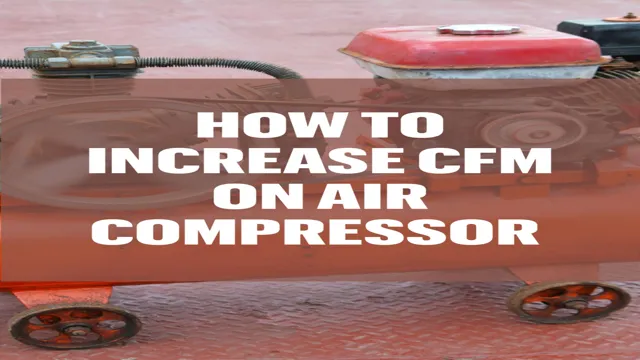
If you’re an avid DIYer, then you know how frustrating it can be when your air compressor stops functioning. Air compressors are used to power various tools, from sanders to nail guns, but when they break down, it can put a wrench in your plans. Thankfully, fixing an air compressor is easier than you might think.
In this blog post, we’ll go over some tips and tricks for fixing your air compressor, so that you can get back to your DIY project in no time. So grab your tools, and let’s get started!
Diagnosing the Problem
When it comes to fixing an air compressor, the first step is to diagnose the problem. Some common issues include low pressure, leaks, and unusual noises. Low pressure could be due to a clogged air filter or a faulty pressure switch.
Leaks may be caused by a damaged hose, a loose connection, or a faulty valve. Unusual noises could indicate a problem with the motor or the pistons. Once you have pinpointed the issue, you can take the next step towards fixing your air compressor.
It is important to follow safety protocols when working with any electrical equipment, so make sure to disconnect the power source and read the manufacturer’s instructions carefully. With the right tools and knowledge, repairing your air compressor may be easier than you think. Remember to regularly maintain your equipment to prevent future breakdowns and prolong the lifespan of your machine.
Checking for Power
Trying to troubleshoot issues with your electronics can be a frustrating experience, especially if you’re not sure where to start. One of the first things to check is if your appliance has power. Even if it seems obvious, checking for power can save you lots of time and effort.
Start by finding the power cord and examining it for any visible damage or loose connections. Next, check that the outlet is working by plugging in a different device. If your outlet isn’t working, try resetting the circuit breaker or fuse.
If your device still isn’t working, it may be due to a fault in the wiring or internal components. If you’re unsure about how to proceed, it’s best to call in a professional to ensure a safe and accurate diagnosis.

Examining the Air Compressor
As an owner of an air compressor, it can be frustrating when it’s not working correctly. The first step in diagnosing the problem is to listen for any unusual sounds coming from the compressor while it’s running. A knocking or rattling sound could mean a problem with the crankshaft or connecting rods.
A hissing noise indicates a leak in the system, which could be from a damaged hose or a broken valve. If the compressor is not producing enough pressure, it could be because of a clogged filter or a faulty pressure switch. It’s essential to inspect the compressor regularly and address any issues promptly to avoid further damage.
By understanding the different signs and symptoms, you can diagnose the problem and determine the best course of action for repairing and maintaining your air compressor.
Replacing Faulty Parts
If you’re experiencing issues with your air compressor, it’s essential to diagnose the problem and replace any faulty parts. Firstly, ensure that the power source is connected and check for any damaged cords or cables. Then, clean or replace the air filter to ensure proper airflow.
If the issue persists, the pressure switch or regulator valve may be the issue and need replacing. Another common problem is a faulty piston or cylinder, which requires a complete rebuild or replacement. It’s best to refer to the manufacturer’s manual for specific instructions on how to repair or replace any faulty parts.
In case you’re not familiar with how to do it yourself, calling a professional is a good idea. Overall, regularly checking and maintaining your air compressor will ensure it lasts longer, runs smoothly, and saves you time and money.
Changing the Filters
Replacing faulty parts is an essential aspect of maintaining a healthy filtration system in your HVAC unit. Over time, the filters in your unit may become clogged, limiting the airflow and reducing the system’s efficiency. You may notice a reduced airflow or increased energy bills as the filters become clogged.
To replace the faulty parts, you’ll need to locate the filter and remove it from the unit. This will require some simple tools like a screwdriver or pliers. Once you’ve removed the filter, inspect it to see if any debris or dust has accumulated on it.
Replace the old filter with a new one of the same size and type. It’s important to replace the filters on a regular basis to ensure the longevity of your system and to maintain a healthy indoor air quality. By changing the filters, you’ll be able to keep your HVAC unit running smoothly and reducing the risk of expensive repairs.
Replacing Belts
When it comes to keeping your machinery running smoothly, replacing faulty parts is crucial. One component that should be regularly checked and replaced is the belt. Over time, belts can become worn or damaged, leading to reduced efficiency or even complete failure.
To avoid unexpected downtime, it’s important to keep an eye out for signs of wear such as cracking, fraying, or unusual noises. In some cases, tightening or adjusting the belt may be enough to resolve the issue, but if the belt is beyond repair, replacement is necessary. By replacing belts as needed, you can ensure that your equipment continues to operate efficiently and reliably, minimizing the risk of costly breakdowns.
So, don’t overlook this important maintenance task, and keep your machinery running at its best!
Switching Out Pressure Switches
Switching out pressure switches can be a daunting task if you’re not familiar with the process. However, it’s a necessary step when dealing with faulty parts in your system. Pressure switches are responsible for monitoring and regulating the pressure within your system, so it’s important to ensure they’re working correctly.
When replacing a faulty switch, it’s crucial to choose the correct replacement part. It’s always recommended to consult with a professional to ensure you’re purchasing the right part for your system. Once you have the replacement part, it’s important to follow the instructions carefully during the installation process.
This will ensure your system is functioning optimally and that you won’t encounter any further issues due to mismatched parts. By switching out pressure switches, you’ll be able to maintain the proper functioning of your system and avoid costly repairs down the line.
Maintenance Tips to Keep Your Air Compressor Running Smoothly
If you want to keep your air compressor running smoothly, regular maintenance is key. Start by checking and changing the filters as needed to prevent dust and debris from clogging the equipment. Keep the compressor’s exterior clean and free of any dirt or grime that can build up over time and impair its performance.
Another important maintenance tip is to regularly drain the tank to keep moisture from accumulating and causing rust or other damage. If you do encounter problems with your air compressor, such as leaks or loss of pressure, the first step is to check the hoses and connections for any signs of wear or leaks. If the issue persists, you may need to replace the compressor’s pump or other components.
Remember to always disconnect the power source before attempting any repairs. By following these maintenance tips, you can ensure that your air compressor is always in top working condition and ready for any project. So, “how do you fix an air compressor?” Regular maintenance will help fix and prevent common issues with air compressors.
Regularly Clean the Air Compressor
Regularly cleaning your air compressor can help keep it running smoothly and efficiently. Over time, dirt and debris can accumulate inside the compressor, causing it to work harder and potentially leading to breakdowns. To prevent this, make sure to regularly clean all of the parts and components of your air compressor.
Start by disconnecting it from the power source and releasing all pressure from the tank. Then, remove any loose debris using a soft-bristled brush or compressed air. Next, clean the air filter and replace it if needed.
And don’t forget to check the oil level and change it if necessary. By taking these simple steps, you can keep your air compressor running smoothly for years to come.
Check for Leaks
To keep your air compressor running smoothly, one crucial maintenance tip is to check for leaks regularly. Leaks can cause your compressor to work harder than necessary, leading to increased wear and tear on the equipment and potentially causing it to break down. To check for leaks, start by inspecting the hoses and connectors for any visible damage or signs of wear.
Next, listen for any hissing noises or feel for any air escaping while the compressor is running. A quick, easy way to locate leaks is to spray a soapy water solution onto the hoses and connectors: if there are any leaks, bubbles will form where the air is escaping. By fixing leaks promptly and regularly checking for new ones, you can extend the life of your compressor and avoid costly repairs in the future.
So, make sure to add “check for leaks” to your regular air compressor maintenance routine.
Conclusion
Fixing an air compressor can be a daunting task, but fear not! It’s as easy as finding the leak, tightening the connections, replacing the faulty parts, and giving it a little TLC. Remember, just like any other relationship, communication is key. Listen to your air compressor and it will tell you what it needs.
So, wipe those sweat beads off your forehead and go show that compressor who’s boss!”
FAQs
How do you troubleshoot an air compressor that won’t turn on?
First, check if the power supply is properly connected. If there is power, check the pressure switch and the motor capacitor. If they are okay, inspect the wiring and the motor itself.
Why does an air compressor keep shutting off before reaching the desired pressure?
This could be due to a faulty pressure switch, leaky valves, or a failing compressor pump. Check the pressure switch adjustment, the tank check valve, and inspect the pump for wear or damage.
What should you do if an air compressor starts making unusual noises?
Stop using it immediately and inspect the pump, motor, and belts for signs of wear or damage. Tighten any loose connections and remove any debris in the unit. If the noise persists, seek professional help.
How often should you change the oil in an air compressor?
It depends on the usage of the compressor, but generally, it should be changed every 500 to 1000 hours of operation or every three to six months. Check the manual for the recommended oil type and change intervals.
Why is the air pressure output lower than usual?
This could be due to a clogged air filter, a dirty or damaged regulator, or a leak in the hose or fittings. Check and clean the air filter, inspect the regulator for damage, and tighten any loose fittings or replace any damaged hoses.
How do you maintain an air compressor?
Regularly check the oil level and change it as needed, clean or replace the air filter, inspect and tighten all connections, and drain the tank after each use. Follow the manufacturer’s guidelines for maintenance intervals and procedures.
How do you choose the right air compressor for your needs?
Consider the intended use, power source, tank size, and cfm output required for your tools. Consult with a professional or refer to the manufacturer’s guidelines to ensure you choose the appropriate size and type of compressor for your needs.








